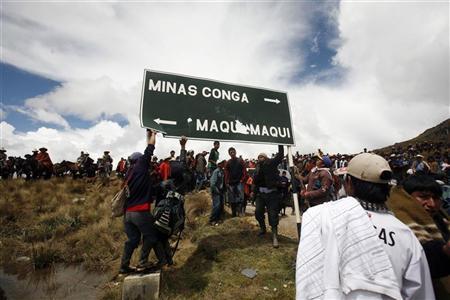Newmont's Conga "on the back burner"
Published by MAC on 2012-08-28Source: Reuters
Although State of Emergency continues in Cajamarca, Peru
Last week Peruvian Prime Minister Juan Jimenez confirmed to the press that the Conga project "has entered a suspension phase, as you may know, a phase that the company decided upon, of course by request of the government and this suggests that we are entering a new scenario." (RPP, Thursday 23 August 2012)
The suspension comes after the publication of results from a respected polling agency, Ipsos-Apoyo that found just 15 percent approve of the Conga project, with 78 percent disapproving and 7 percent with no opinion.
The state of emergency in the Cajamarca region, however, has not been lifted and debates continue on the significance of the suspension for the mining industry, for the government's handling of the mining conflict, more importantly for the people of Cajamarca.
Newmont mine "on back burner": Peru cabinet chief
Reuters
24 August 2012
 |
| Andean people destroy a sign of Newmont Mining during a protest against the company's proposed $4.8 billion Conga gold mine, near the Cortada lagoon, in the Andean region of Cajamarca November 24, 2011. Photo: Enrique Castro-Mendivil |
Newmont Mining Corp's $5 billion Conga gold project is "on the back burner," Peru's government said on Thursday - a sign that it will stop trying to overcome local opposition that has resulted in violence and two cabinet shuffles.
Prime Minister Juan Jimenez made the comments after a poll by survey firm Ipsos showed 78 percent of people in the northern Peruvian region of Cajamarca opposed the planned mine.
The high-profile conflict has dominated President Ollanta Humala's first year in office, resulting in five deaths in Cajamarca and instability in his cabinet.
Humala has tried to show investors that he is committed to projects in Peru's $50 billion pipeline of planned mines, but critics say left-wing political leaders in Cajamarca have outmaneuvered him.
Now the situation has entered "a new phase," Jimenez told reporters. "We need to build a positive agenda that means people can work normally and stop demonstrations."
Shops in Cajamarca have often been shuttered since protests against the project gained force in November.
Locals fear the project, essentially an expansion of the Yanacocha mine in Cajamarca, will cause contamination and ruin local water sources essential to their agricultural livelihoods.
Newmont says reservoirs it would build will provide year-round water supplies in areas that currently suffer during the dry season.
The Conga mine would be one of the biggest investments in Peru's history. Mining makes up 60 percent of the nation's export earnings and has traditionally powered its economy, although towns near mines often are plagued by poverty.
The project has become a lightning rod for debates about whether mining can benefit local communities without damaging the environment, and whether national economic interests should trump local opposition to extractive activities.
"It's dead," Gregorio Santos, the left-wing Cajamarca president who has led rallies against the mine, said via Twitter on Wednesday after the poll results.
Other polls have shown nationwide support for Conga. A separate Ipsos poll this month found that nationally, 45 percent of Peruvians support it, while 40 percent oppose it.
Newmont, whose Chief Executive Officer Richard O'Brien was in Peru last week, said in July that Conga "will occur only with local and national support ... Conga is still in our plans but moving ahead on a very measured basis."
Mining analysts have said the company might wait to build the mine until after Santos leaves office in 2014. He is widely expected to be eying a bid for president in 2016, when Humala cannot run for a second-straight term.
Newmont holds 51.35 percent of Conga, and Peru's Buenaventura owns 43.65 percent. Five percent is held by International Finance Corp.
Newmont and Buenaventura operate Yanacocha, which is one of the largest gold producers in Latin America. It produced 1.5 million ounces of gold in 2010.
Conga would produce between 580,000 and 680,000 ounces of gold annually in its first five years of operation and run for about 19 years.
(Reporting by Terry Wade; Editing by Lisa Von Ahn)